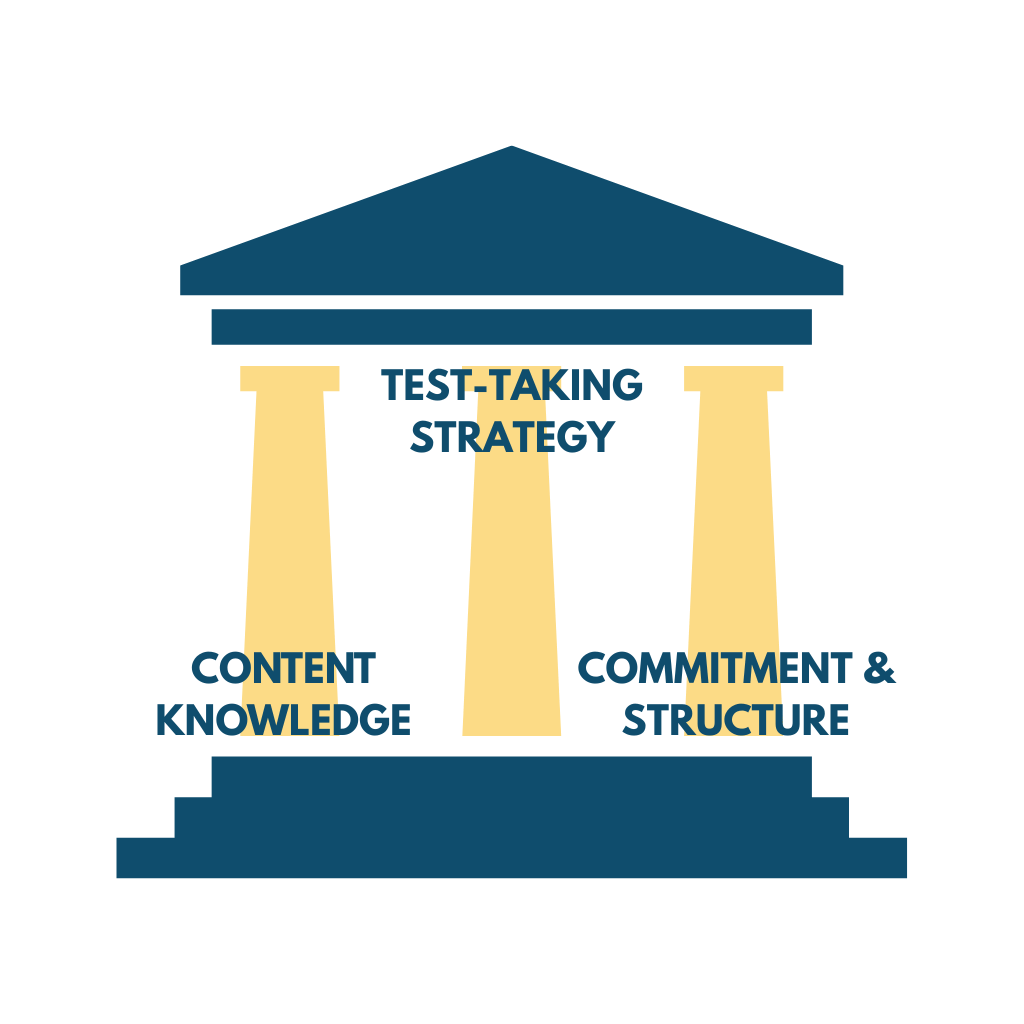A Failed Pediatric Boards Step-By-Step Solution
Why Do So Many Pediatricians Fail the Boards?

If you've had a failed pediatric boards experience, it can feel like a personal failure. You can feel shame, anger, resentment, and even feel like you aren't worthy of being a pediatrician. You aren't alone. In most cases, though, it has less to do with your intelligence and everything to do with your strategy, system, and approach.
5 Key Steps to Take After Failing the Pediatric Boards
|
Table of Contents
- Why Do So Many Pediatricians Fail the Boards?
- The Most Common Reasons Pediatricians Fail
- Why Timing Matters More Than Ever
- Now Is the Time to Shift Your Approach
- What Is the Best Study Plan After Failing?
- How Should I Structure Weeks 1–6?
- What Should I Do in Weeks 7–10?
- How Do I Reinforce Retention in Weeks 11–14?
- What Happens in the Final Two Weeks?
- How Can I Improve My Exam Performance Before Test Day?
- What Results Has This System Produced?
- What Is the VIP Bundle and Why Do I Recommend It?
- Frequently Asked Questions About Failing the Pediatric Boards
- What Should I Do Right Now? (Next Steps)
I'm Dr. Ashish Goyal, a board-certified pediatrician, a board-certified internal medicine physician, and the founder of Pediatrics Board Review (PBR). I failed the pediatric boards the first time I took them, so I understand how demoralizing it is to fail. You question your knowledge, training, and professional identity.
But, after helping thousands of pediatricians pass their boards, I've learned that failing the exam is rarely about knowledge alone. In fact, the most common reasons for failure have nothing to do with how smart you are. Instead, they have to do with what you study, how you prepare, and how you approach the exam itself.
The Most Common Reasons Pediatricians Fail
Through years of experience coaching high-risk test-takers, I've identified three patterns that lead to failure:
- Using too many resources. Instead of going deep with one proven system, they jump between question banks, dense textbooks, and overwhelming live courses. This creates confusion and overload.
- Studying from questions. It's a common misbelief that you should study from questions. For the pediatric boards, this is the wrong approach. Because questions do not provide a comprehensive review and only cover small areas of content in a randomized way.
- Poor test-taking strategy. Board review questions include artificial patient cases that should be approached differently from real life. These questions have weaknesses that can be exploited and should be used as tools to hone your test-taking strategy, not to learn the core content.
- Lack of repetition. Many test-takers only review the core content only once, or less than once. As a result, they forget what they've studied and never have mastery over the content.
- Inconsistent or unstructured study routines. Without a clear plan to approach board preparation as a marathon and not a sprint, pediatricians study in a distracted manner, they run out of time, or they burn out. Instead of deep study, they have shallow study.
If you've had a failed pediatric boards result before, I'm sure these mistakes sound familiar. The American Board of Pediatrics (ABP) doesn't just test your knowledge. It tests your ability to recall and apply information quickly under pressure.
Drawing from USMLE Step 1 data, where international medical graduates have first-time pass rates similar to those of the pediatric boards, and their repeat pass rates are around 50%, it's reasonable to estimate that repeat pediatric board exam test-takers also have a pass rate of approximately 50%. That's why you need an easy-to-follow system with a strategy that builds content mastery through structured repetition, develops test-taking skill, and prepares you for the rigors of a demanding exam.
Why Timing Matters More Than Ever
The official pass rate report from the ABP shows that the pass rate typically ranges between 80 and 82%. However, in 2024, the ABP's first-time pass rate jumped to 89%, the highest it's been in over five years. When the pass rate spikes, it often drops the following year. For example, from 2020 to 2021, the pass rate decreased from 87% to 81%.
In 2024, there was also an unexpected delay in releasing the exam results. That raised questions across the pediatric community, including in this Reddit post I wrote. While we don't know exactly why the delay occurred, we know that the ABP can adjust the exam's difficulty levels when needed. This was clearly demonstrated in 2012 when the ABP pass rate increased by 10% after scoring changes were implemented.
But, if history repeats itself, the 2025 exam pass rate could be lower than the 2024 exam because of the seesaw effect noted repeatedly.
Now Is the Time to Shift Your Approach
If you failed the pediatric boards and want a different result, you need a different system. You don't need more books or longer study days. What you need is a structured plan that prioritizes repetition, timing, strategy, and stamina.
In the next section, I'll walk you through an abridged version of a 16-week study plan I created. This plan has helped repeat test-takers pass after multiple failed attempts.
What Is the Best Study Plan After Failing the Pediatric Boards?
This 16-week study plan is designed specifically for those who have previously failed because a structured, strategic, and repetition-based system is needed to improve their retention, test-taking skills, and overall confidence.
This plan isn't about cramming more hours into your day. It's about maximizing the effectiveness of every study session so that by the time you sit for the exam, you've reinforced high-yield information multiple times and trained yourself with test-taking strategies to answer questions the way the ABP expects you to.
This study plan follows three core principles:
- Multiple rounds of content review to reinforce high-yield topics
- Test-taking strategy development to avoid common mistakes and exploit weaknesses in questions
- Simulated exam conditions to improve stamina and test performance
Since founding PBR in 2011, I've helped thousands of pediatricians pass the boards, including many who had failed multiple times. When I went through this process myself, I increased my board score by over 40%. And through the curated system I've built, including our Live Test-Taking Strategies and Deep Study Course, others have increased their scores by 30% or more.
This plan includes the same structure taught to our VIP Bundle members. It combines content mastery, test-taking strategy, and study discipline into one cohesive path.
How Should I Structure Weeks 1–6? (Deep Learning & First Pass)
Goal: Build a foundation of understanding using only PBR resources. Read everything thoroughly, annotate with clarifications, and use my highlighter method to highlight anything you need to review again.
- Read the PBR Core Study Guide and Q&A Book completely
- Use a light highlighter (e.g., yellow) for anything that needs a second look
- Maintain a steady pace of ~18 minutes per page for deep comprehension
- Answer 35 AAP PREP® questions per week (5 per day)
- Plan for ~5 minutes per question, which includes time to both answer and review the explanation
- Use the audio course during commutes and other available times throughout the 16 weeks
Reading Time: ~120 hoursQuestion Time: 210 questions × 5 min = ~17.5 hoursTotal Time: ~137.5 hours
What Should I Do in Weeks 7–10? (Second Pass & Speed Building)
Goal: Reinforce the content and increase speed. Focus only on the previously highlighted areas.
- Re-read only the yellow-highlighted material
- Use a second highlighter (e.g., pink) layered on top of yellow for anything still unclear
- Increase reading pace to ~12 minutes per page
- Continue answering 35 questions per week (batch sets optional)
Reading Time: ~80 hoursQuestion Time: 140 questions × 5 min = ~11.7 hoursTotal Time: ~91.7 hours
How Do I Reinforce Retention in Weeks 11–14? (Third and Fourth Passes)
Goal: Sharpen recall and focus on truly high-yield, challenging topics.
- Third Pass: Review only pink-highlighted content and add a third color (e.g., orange) for remaining weak spots
- Use the PBR Online Video Course for multimodal studying and highlight any areas in your books that warrant further review
- Fourth Pass: Focus solely on orange-highlighted sections
- Increase pace to ~8 minutes per page
- Use active recall: quiz yourself before re-reading
- Continue practicing with 35 questions per week, batching into sets of 15–20 for stamina
Reading Time: ~110 hours (55 hours per pass)Question Time: 140 questions × 5 min = ~11.7 hoursTotal Time: ~121.7 hours
What Happens in the Final Two Weeks? (Final Review & Exam Simulation)
Goal: Solidify knowledge, build confidence, and prepare for real test conditions.
- Fifth Pass: Focus only on your most challenging material using a final highlighter (e.g., blue) layered over prior colors
- Review just blue-highlighted sections for maximum efficiency
- Read at a pace of ~6 minutes per page for familiar material
- Complete a full-length mock exam (334 questions) under timed conditions
- Finish the remaining AAP PREP® questions (~210) in short, focused blocks at exam speed (75 seconds per question)
Reading Time: ~40 hoursMock Exam: 334 questions × 5 min = ~27.8 hoursAdditional Questions: 210 questions × 5 min = ~17.5 hoursTotal Time: ~85.3 hours
How Can I Improve My Exam Performance Before Test Day?
Studying content is critical, but it's not enough. Many pediatricians fail because they haven't trained for the actual test day experience. If you're not prepared for the mental, physical, and pacing demands of the board exam, even strong content knowledge can fall short.
You need to simulate the exam environment to build stamina and to reduce test-day anxiety. Practicing this in advance can dramatically improve your focus, timing, and confidence.
What Does an Effective Mock Exam Look Like?

A mock exam isn't just about testing your knowledge. It's about evaluating your endurance and practicing the same pacing and decision-making you'll need during the real thing.
Here's how to simulate the exam environment effectively:
- Take at least one full-length mock exam with the same number of questions and block structure as the real exam
- Use the ABP's actual break timing to mirror the real-day rhythm
- Start your exam at the same time of day as your actual test
- Use the same tools you'll use at the test center (e.g., a whiteboard or laminated sheet with a dry erase marker)
- Complete the entire exam without stopping to check for answers
This experience isn't about your mock exam score. It's about evaluating your ability to stay alert, focused, and consistent across a full day testing. If you've never done this before, it's one of the simplest ways to prepare yourself more effectively than most other test-takers.
If you want in-depth information on the exam day structure, number of questions, number of breaks, and guidance through a step-by-step breakdown of how to optimize your exam-day routine, read the PBR exam day success guide.
How Should I Study in the Final Two Weeks Before My Exam?
At this point, your goal is no longer to learn new material. It's to reinforce what you already know and ensure it's top of mind. The last two weeks are critical for confidence, speed, and recall.
Here's how to focus your time:
- Prioritize your blue-highlighted content since these are the areas you identified as needing additional repetition
- Do not introduce new sources of information or unfamiliar topics
- Avoid long marathons of studying so that you can have deeper study sessions for more effective memory recall based on your personal ability to maintain focused attention
- Batch your questions in smaller sets (12–18), focusing on pacing, confidence, and clarity
- Do not study past 6 PM on the day before the exam
- Sleep well, hydrate, and reduce stress. This is when your mindset matters just as much as your knowledge.
By following the 16-week plan, you've already studied more strategically than most test-takers. These final two weeks are about locking everything into place.
What Results Has This System Produced?
You're not alone if you've failed the pediatric boards. I've worked with physicians who failed once, twice, or even ten times, and they eventually passed.
The key wasn't trying harder. It was following a proven system. Below are just a few examples of pediatricians whose lives changed after enrolling in the PBR VIP Bundle and following my blueprint.
Dr. Yessenia Castro Passed After Five Failures and Got a $20K Raise
Dr. Castro failed the boards five times. Each time, she studied harder and tried more resources. But her approach was unstructured and lacked a focus on test-taking strategy. Eventually, she joined me at one of my Live Test-Taking Strategies & Deep Study Courses and committed to fully using the system.
She passed.
Shortly after passing, she landed a job that paid her $20,000 more per year.
You can read more about her success and others like hers in our 2024 Pediatric Board Exam Results & Insights.
How Dr. Kerri Lockhart Recovered from Two Failures
Dr. Lockhart had never failed a medical board exam until the pediatric boards. She failed twice despite using well-known review resources that you are familiar with. After joining PBR, she stopped jumping between tools and started following PBR's system. She used structured repetition and refined her test-taking strategy.
She passed on her next attempt.
She was also a member of the PBR Live Test-Taking Strategies & Deep Study Course.
How Dr. Pablo Chagoya Passed on His 10th Attempt
Dr. Pablo Chagoya took the boards nine times and failed. After nearly giving up, he committed to another attempt. He used the full PBR system and received help from Team PBR.
- He attended the Live Test-Taking Strategies Course.
- He paid attention to the Deep Study and Mastering Board Exams lectures.
- He followed the system.
- He passed on his 10th attempt. If Pablo passed on his 10th attempt with this system, don't you think he could have passed on his first attempt with the same system and intention?
These are just a few examples of what's possible when you stop trying to figure it out on your own and start following a system designed with careful consideration and years of experience.
What Is the VIP Bundle, and Why Do I Strongly Recommend It For You?
If you've failed the pediatric boards, you are automatically considered high risk. And for high-risk test-takers, the VIP Bundle isn't just a “suggestion,” it's a requirement.
Why? Because it's the only resource that supports all three pillars of board exam success. It's the same framework that helped me pass after failing and that has helped countless pediatricians like Yessenia, Kerri, and Pablo pass since 2011.
What Are the Three Pillars of Board Exam Success?

Every pediatrician who wants to pass the boards needs to reliably build strength in these three areas:
- Content Knowledge: You need to know the material well enough to recall it quickly under pressure
- Test-Taking Strategy: You must understand how to systematically approach ABP-style questions, avoid traps, and take advantage of common weaknesses in board-style questions
- Commitment & Structure: You need a study plan that's clear, realistic, built on repetition, and works for any pediatrician
If you're missing even one of these pillars, your chances of passing drop significantly.
The VIP Bundle is the only package I offer that fully addresses all three. If you're unfamiliar with the pillars, I recommend reading this overview of the Three Pillars of Board Exam Success.
What's Included in the VIP Bundle?
Here's what you get when you enroll in the VIP Bundle:
- 100% of PBR's knowledge-based resources, including the Core Study Guide, Q&A Book, Online Video Course, Audio Course, Virtual Atlas of Pediatric Pictures, “Ask the Expert” webinars, Personalized Study Schedules, and more
- The Online Test-Taking Strategies Course, which lays the groundwork for developing better question-processing habits and prepares you for the Live Test-Taking Strategies & Deep Study Course
- The Live Test-Taking Strategies & Deep Study Course, where I teach board-style question algorithms that have helped physicians improve their scores by 20–30% immediately
- The Deep Study and Mastering Board Exams lectures, which show you how to study smarter, manage distractions, build stamina, and optimize your exam day performance
- Customized, 90-day Personalized Study Schedules created by my team to match your availability, risk level, and study pace
I've helped thousands of pediatricians pass their board exams since 2011, many after multiple failed attempts. I personally increased my own score by over 40%, and I've seen members who commit to this easy-to-follow system raise their scores by just as much.
This is the same system that helped Dr. Pablo Chagoya pass on his 10th attempt, and it's helped others pass after failing five or even six times.
If you're serious about passing, this is the most important next step you can take.
Frequently Asked Questions About Failing the Pediatric Boards
If you’ve recently failed the pediatric boards and worried about what happens next, you’re not alone. Below are answers to some of the most common questions pediatricians ask after failing. These are based on real-world concerns and the latest guidance from the American Board of Pediatrics.
How many times can you fail the pediatric boards?
There is no formal limit to how many times you can take the American Board of Pediatrics (ABP) initial certification exam. However, you must pass within 7 years of completing your pediatric residency to maintain eligibility. If you do not pass within the 7-year time limit, you must undergo required training to become board eligible again.
Can you still practice as a pediatrician if you fail your boards?
Yes, but with limitations. You can still practice as a general pediatrician with a valid medical license, even if you haven't passed the pediatric boards. However, most employers require board certification within 3 years of completing residency. This especially goes for hospitals and large group practices.
Additionally, you cannot take any pediatric subspecialty board exams (e.g., pediatric cardiology, neonatology) until after you pass the ABP initial certification exam.
What percentage of questions do you need to get right to pass?
The ABP does not publish an exact passing percentage. According to their official scoring FAQs, the required percentage correct varies depending on the difficulty of the exam version you receive. Because each test form may differ slightly in difficulty, a fixed “passing percentage” is not made available.
What percentage of people pass the pediatric boards?
From 2015 to 2024, the average first-time pass rate was 85.2 percent. In 2019 the pass rate spiked to 91% and in 2024 it spiked to 89%. However, these types of spikes are often followed by drops in the following years as low as 80%. For the national for repeat test-takers, we estimate the pass rate is estimated to be around 50 percent, making the need for a strategic plan even more critical if you’ve failed before.
Is the pediatric board exam hard?
Yes. It's widely known that the pediatric board exam is one of the most difficult medical board exams, especially for first-time test-takers. The volume of content, time demands, and exam structure make it unlike any medical exam taken during residency or medical school. That’s why preparation needs to be smarter, not just harder.
How long does it take to study for the pediatric boards?
It depends on your risk profile and available time. For low-risk test-takers, we recommend a minimum of 300 hours of preparation. For moderate- to high-risk test-takers, the recommendation is at least 500 hours. For some test-takers, more hours are needed because of personal factors (e.g., stamina, attention to detail, recall, ADHD, etc.).
While the number of hours needed to prepare is important, the proximity of your board preparation to the date of your exam must also be taken into account as you structure your time. Ideally, your final two readings of your core content should take place in the last two months before the exam to maximize retention and recall.
Should I study the weak areas from my score report?
No. You should not study based on the lower-scoring areas of your score report. It may seem logical to use your pediatric board exam score report as a guide for what to study, but in most cases, that's a mistake.
Unless you've failed the exam multiple times and see the exact same area consistently showing low scores, the score report is not a reliable indicator of what you truly need to work on. The report reflects only a small percentage of each content area that was tested. For some sections, even missing just one or two questions can dramatically affect your score.
So, instead of chasing after your “lowest section,” focus on mastering all core content through structured repetition. To do this, you need a pediatric board review course that is concise and repeatable. Going through curated material with my highlighter method will naturally isolate the content you need to work on.
What Should I Do Right Now? (Next Steps)
You've made it this far for a reason. You're serious about passing the pediatric boards. You now understand more about PBR's system. It's not a harder system. It's a smarter system that offers you a clear path forward.
Whether you've failed once or multiple times, the key to success is no longer to “just study harder.” It's time to study smarter, with a proven system that's easy to follow and built with repeat test-takers in mind.
Step 1: Download Your Custom Action Plan to Recover and Pass
I've created a free blueprint specifically for high-risk and repeat test-takers. This downloadable action plan will show you exactly what to do next so you can stop guessing, stop spinning, and start moving toward a pass.
In this free plan, you’ll discover:
- The Three Pillars of Board Success (and how to fix what’s missing)
- The catastrophic mistakes repeat test-takers make—and how to avoid them
- How to rewire your study process using the Highlighter Method
- Why strategy, not more studying, is your fastest path to higher scores
- A step-by-step system that takes the guesswork out of your prep and helps you stay consistent from day one to test day
You don't need to guess what to do. Let this action plan guide you.
Step 2: Enroll in the VIP Bundle If You've Failed Before
If you've failed any medical board exam, you're at high risk for failing the pediatric boards. And the VIP Bundle is the strongest recommendation I can make.
It's not just a study tool. It's a complete system built on the Three Pillars of Board Exam Success:
- Content Knowledge
- Test-Taking Strategy
- Commitment and Structure
It includes the exact plan, resources, lectures, and live coaching that have helped physicians pass after failing five, six, or even ten times.
You've worked too hard to let one exam stand in your way. Now you know what to do and have the tools to do it.
What Happens When You Commit?
You follow the plan.
You study with purpose.
You make steady progress.
And you walk into the test with confidence.
If you want to pass the boards, this is your next step, and my team and I are here to help you do it.
Ready to Take the Next Step?
If you're serious about maximizing your chances of passing the pediatric boards, leverage the easy-to-follow, formulaic systems that Pediatrics Board Review (PBR) has to offer through the PBR VIP Bundle. I built PBR after failing the boards myself, and every tool, tip, and strategy is designed to help you study smarter, not harder.
From first-time test-taker to those who recovering from a failed pediatric boards experience, we give you a proven, supportive framework to simplify your studying, approach your board prep strategically, and walk into the exam with confidence.
Need help deciding what’s right for you?Click here and contact my team for personalized guidance from experts who’ve helped thousands of pediatricians succeed.
Pediatrics Board Review is your all-in-one study service guide designed for pediatricians by board-certified pediatricians. Dr. Ashish Goyal has been helping pediatricians pass their initial certification exams and maintenance of certification exams since 2011.



